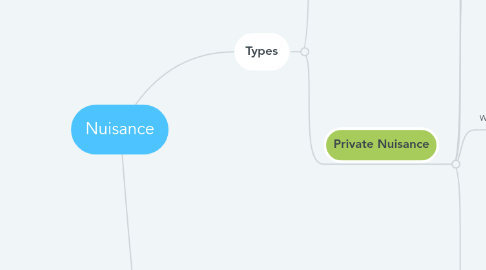
1. Types
1.1. Public Nuisance
1.1.1. Definition
1.1.1.1. Attorney General v PYA Quarries Ltd
1.1.1.1.1. Arises when an act materially affect the reasonable comfort and convenience of life of a class of the society
1.1.2. Who can claim ?
1.1.2.1. Criminal proceedings
1.1.2.1.1. Public prosecutor on behalf of the government
1.1.2.2. Civil proceeding
1.1.2.2.1. No special damage suffered by any particular individual
1.1.2.3. Civil proceeding
1.1.2.3.1. Person who suffers special or particular damage
1.2. Private Nuisance
1.2.1. Definition
1.2.1.1. Read v Lyons
1.2.1.1.1. An unlawful, substantial and unreasonable interference with a person's use, comfort, enjoyment and any interest that a person may have over his land
1.2.2. Elements
1.2.2.1. Substantial Interference
1.2.2.1.1. It is not actionable per se.
1.2.2.2. Unreasoableness
1.2.2.2.1. Guidelines to determine the unreasonableness
1.2.3. Who can sue ?
1.2.3.1. Landowner
1.2.3.2. Occupier
1.2.3.3. Reversoner
1.2.4. Who can be sued ?
1.2.4.1. Creator
1.2.4.1.1. Marcic v Thames Water Utilities Ltd
1.2.4.2. Occupier
1.2.4.2.1. Servant or employee
1.2.4.2.2. Independent contractor
1.2.4.2.3. Trespasser
1.2.4.2.4. Liscensees
1.2.4.2.5. Natural causes
1.2.4.2.6. Conduct of previous occupier
1.2.4.3. Landowner or landlord
1.2.4.3.1. If he has authorised the nuisance
1.2.4.3.2. If he knew or ought to have known of the nuisance before the tenancy became effective
1.2.4.3.3. If he has covenanted to repair or has a right to enter the premises to conduct repair works
1.2.4.4. Local authority/ government
1.2.4.4.1. Koperasi Pasaraya v UDA Holdings Sdn Bhd
2. Defences
2.1. 1. Prescription
2.1.1. Applicable to private nuisance
2.1.1.1. Sturges v Bridgman
2.2. 2. Statutory authority
2.2.1. Manchester Corp v Farnworth
2.3. 3. Other defences
2.3.1. Necessity
2.3.2. Consent
2.3.3. Defence of property
2.3.4. Contributory negligence
